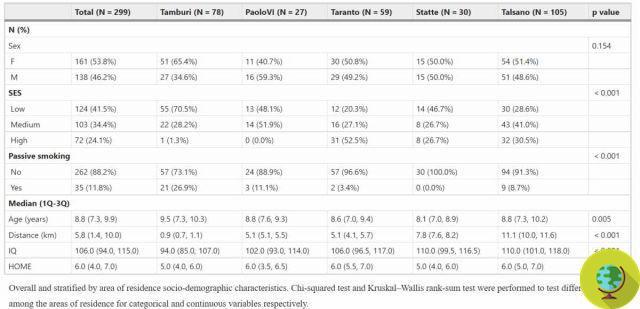One study investigated the association between exposure to neurotoxic elements and the neurobehavioral outcomes of children from Taranto.
Don't store avocado like this: it's dangerousA new study explored the association between exposure to potentially neurotoxic elements and the neurobehavioral outcomes of children born and raised around the former Ilva di Taranto
Behavioral disorders and increased hyperactivity, psychopathological traits and risks of autism, as well as anxiety, depression and a lower IQ. The former Ilva of Taranto has brought big troubles: not only respiratory diseases, circulatory system and different types of tumors, but also neurological risks for those "children of Ilva”Who are the victims most affected by the poisons of the largest coal factory in Europe.
This is what emerges from a research published in the international journal Nature that demonstrates the synergistic neurotoxic effects of lead and arsenic and other metals on children of Taranto residing in neighborhoods near the industrial center.
A problem that has always existed (the dossier of the Ministry of Health that opened similar scenarios dates back to 2016) and that has always highlighted the Committee for Health and for the Environment of Taranto (to which Peacelink, Parents Tarantini, Committee Quartiere Tamburi adhere, Article 32, LiberiAmo Taranto and Lovely Taranto) who sent a letter to the ministers Cingolani and Speranza in which he asked to:
deny the rumors that a new save-Ilva decree is imminent, which would be a serious act of arrogance and irresponsibility. We are writing to inform you that we intend to contact the United Nations Committee on the Rights of the Child, based in Geneva to report this situation of the children of Taranto with lead in their blood and arsenic in their urine.
SERIOUS NEUROLOGICAL DISORDERS IN TARANTO CHILDREN: WHAT DO WE WANT TO DO? We find the immobility of the ...
Posted by Justice for Taranto on Sunday, June 20, 2021
A systematic review
Neurodevelopmental disorders are steadily increasing on a global scale and elements such as heavy metals have been known to be neurotoxic for some time. In this cross-sectional study, the neurobehavioral effect of exposure to trace elements including lead, mercury, cadmium, manganese, arsenic and selenium and their interactions between 299 schoolchildren residents in the heavily polluted area of Taranto. Whole blood, urine, and hair were collected for metal analyzes, while the Child Behavior Checklist and Social Responsiveness Scale were administered to the principal teacher and mothers to identify behavioral problems in children.
The presence of lead in the blood showed mainly social problems, aggressive behaviors and externalization, while the arsenic in the urine showed an impact on anxiety and depression, somatic problems, attention problems and violation of the rules. A significant interaction between lead and arsenic was observed, with a synergistic effect of the two metals increasing the risk of attention problems, aggressive behavior, outsourcing problems and total problems.
Specifically, the study evaluated the neurobehavioral effect of exposure to some elements including Pb, Hg, Cd, Mn, As and Se among children aged 6 to 11 living in the heavily polluted area. Well, two of the neighborhoods closest to the industrial pole (Tamburi and Paolo VI) were characterized by a lower percentage of high-level socio-economic status (SES) (respectively 1,3% and 0%, p-value of the Chi-square <0,001), higher frequency of exposure to secondhand smoke (26,9% and 11,1%, respectively, chi-squared p-value <0,001), and lower intelligence quotient (IQ) (median IQ 94 and 102, compared to 110 in the Statte and Talsano neighborhoods, Kruskall – Wallis p-value <0,001). Children residing in Tamburi also showed lower cognitive stimulation at home (median total score (1Q-3Q) HOME equal to 5,0 (4,0, 6,0), Kruskall-Wallis p-value <0,001), were slightly older and had a higher percentage of females than children who lived farther from the source.

©Nature
Overall, we were able to test that higher blood lead, urinary arsenic concentrations and their interaction increase the risk of neurobehavioral problems. This is in line with the United States Environmental Protection Agency's Priority List of Hazardous Substances where arsenic and lead are ranked first and second, respectively, the study reads.
This study also highlights how disadvantaged areas are at increased risk of neurobehavioral problems in addition to the risk of decreased neurocognitive abilities. A disaster, a real disaster. And who knows how long the new generations will pay for it.
Source: Nature
Read also:
- Fired by the former Ilva for sharing an "uncomfortable" post for the company. Sabrina Ferilli offers him a salary and legal assistance
- Because steel will crush (and pollute) Taranto "doubly": the mockery of the new agreement on Ilva
- ArcelorMittal's new Ilva pollutes more than before: ARPA data
- Ex Ilva, the prosecutor is investigating the red and toxic cloud that has enveloped Taranto
- Toxic wind in Taranto: the disturbing images of the dusts that rise in the air from the Ex Ilva
- In Taranto people continue to really die: the torchlight procession to remember the children killed by pollution


























